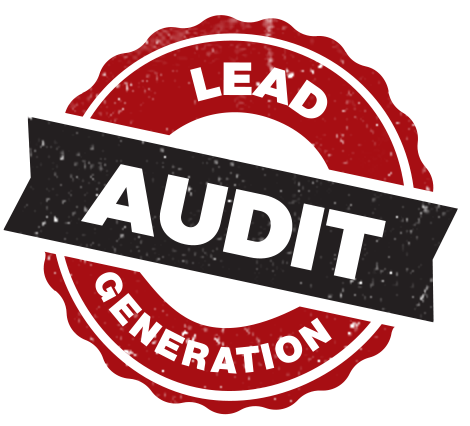Posted by Rich Harshaw on March 16, 2017.
Topics: Advertising,
Contractor Marketing,
Contractor Seminars,
Identity,
Internet Marketing,
Make The Jump,
Online Reputation Management,
Pay Per Click,
PPC,
Price Conditioning,
Radio,
Rich Harshaw Seminars,
SEO,
Web Marketing,
Websites.

If you’re serious about getting to $10MM, you’re going to have to Master internet marketing.
That’s Master, with a capital M.
Like Steph Curry is the Master of the 3-point shot.
But honestly, most remodelers are more like a fat kid hoisting 3’s in his driveway. They’re just not very good at internet marketing
But Mastery is non-negotiable—if you want to get to $10MM. Here’s why:
1. Every lead you ever get from any source is going to check out your website. All of them. And if you’re not careful, your website will scare them off—without you even knowing it.
2. There are a TON of prospects wandering around the internet just waiting to be captured by you… or somebody else who is better at doing so.
To learn more about the Make The Jump Event click here.
In terms of websites: yours MUST be fresh, clean, and current. It has to turn LOOKERS into BUYERS. You have to build a case for why you’re different and better than your competitors. You have to show them plenty of evidence. You have to be convincing.
Especially considering your prices are going to be 50% to 150% higher than your competitors.
Fat kid in the driveway isn’t going to cut it.
Want to see what your website SHOULD look like? Click here, here, here, or here.
If you want to learn more about what goes into a great website, watch this webinar.
Now let’s shift gears and talk about SEO & PPC.
These are two of the least understood weapons in the remodeler’s toolkits—because sellers of SEO & PPC have been ripping remodelers off for well over a decade now.
Everyone has stories of failure and doom. And most of them are true. You do have to be careful when wading into these waters.
But flushing SEO & PPC down the toilet because some company ripped you off makes no more sense than homeowners flushing remodeling down the toilet because contractors have a bad reputation.
Get over it—there are hundreds and hundreds of leads just WAITING to be captured.
Obviously, you have to have a killer website or else the prospects that land on your site are going to draw the natural conclusion that you suck. Airball.
But beyond that, what are the rules? How does it work? What should you do?
For SEO, it’s simple. You have to add TONS and TONS and TONS of relevant, interesting, and well-written content and add it to your site.
Every. Single. Month.
Content can mean articles, blog posts, videos, geographic-specific pages, product-specific pages, case studies, project photos, online reviews—just to name a few.
Google sees all that stuff and rates you higher than your competitors who don’t put in the time and effort to do so. It’s just that simple.
But still, most SEO companies try to shortcut the process. The key words above were “relevant, interesting, and well-written.” Most companies settle for poorly written, irrelevant, and uninteresting.
Fat kid hoisting 3’s in the driveway.
And they wonder why Google keeps crucifying them.
SEO to the level you need to get to $10MM is going to cost you about $1,200 to $3,000 a month—and it strictly depends on how aggressive and good your competitors are (at SEO).
Most of our clients are on a $1,200 a month plan and are riding first page (and many #1) rankings… and rising. A few of our clients pay double that because they are in super competitive markets, or they have a few really bad reviews that we have to bury. (note: bad reviews does NOT necessarily mean they are a bad company. It often means that some idiot jack-wagon has a vendetta against them. You also need to actively manage your online reputation and reviews).
Not doing SEO is not an option. It’s 100% mandatory.
But what about PPC?
To be a $10MM company, you’re going to want to Master this one as well.
To learn more about the Make The Jump Event click here.
Google recently changed the way its search results look. The top FOUR spots are now ads, then a map, and then the “organic” (SEO) results.
Take a look:
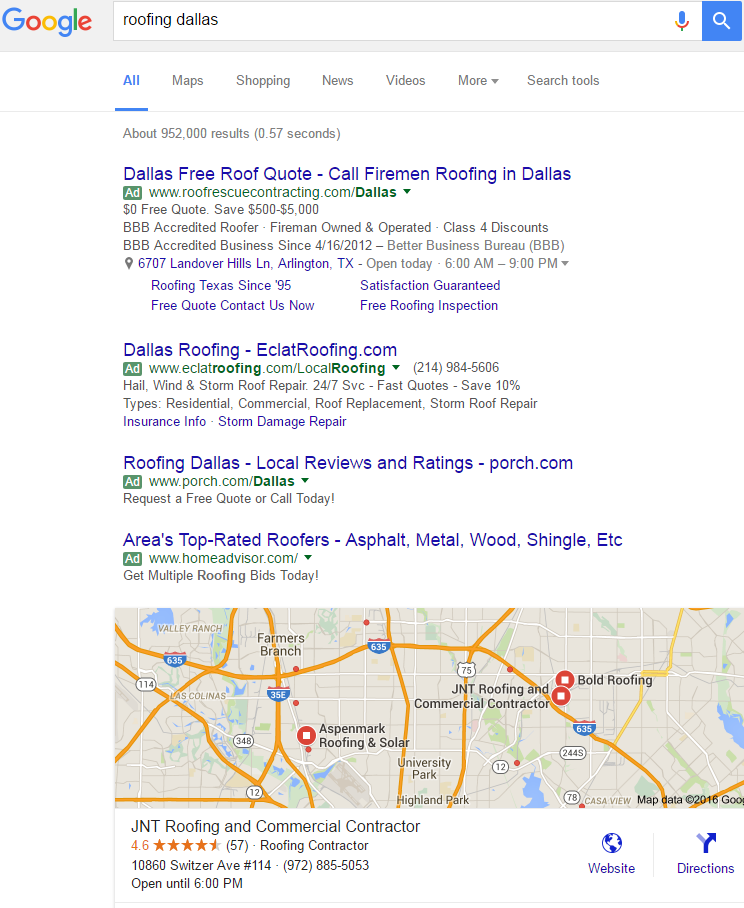
Let me give you the short course on PPC, then give you some links to read more if you want.
PPC providers are worse than the SEO guys. There are a TON of them that have ZERO clue what they are doing. Most of them are simply taking your money and putting it on an online automated bidding platform that takes a huge chunk of the money you paid to use. You never know this except when you get crappy results. I want to emphasize—they literally have no idea what they are doing. None.
Fat kid in the driveway trying to shoot a medicine ball.
The few that don’t use an automated system have SOME clue, but almost always are generating fewer leads than you should be getting.
To get to $10MM, you have to find a great PPC company, then once you’re satisfied they’re good, SPEND AS MUCH MONEY AS POSSIBLE WITH THEM!
Why? Because every dollar they spend is going to bring you leads.
But not just leads. Leads from the people who are actively trying to find somebody to buy from!!!!
Once you have a great website and you’ve Mastered SEO & PPC, you’re ready to talk about MEDIA advertising. Radio and TV.
And radio and TV is what is going to make you a millionaire.
Next post, I’ll explain how.
Happy Marketing! For info about the upcoming 2-day seminar, click here.
P.S. Here’s a great webinar I did on SEO & PPC called “The No BS Webinar On SEO & PPC”

Save
Save
Save
Save
Save
Save
Posted by Rich Harshaw on March 15, 2017.
Topics: Advertising,
Contractor Marketing,
Contractor Seminars,
Make The Jump,
Marketing,
Media Buying,
Pay Per Click,
PPC,
Rich Harshaw Seminars,
SEO,
Web Marketing.

Early in my career, I thought I would perform a noble service for my clients by helping them minimize their advertising expenses.
Specifically, I was consulting with an $8MM sunroom and window company in Savannah, GA, and helping them manage a $100,000 a month advertising budget.
About 2 or 3 months into the relationship, I nipped and tucked different parts of the budget, and got it down to about $85,000. I was excited to have “saved” my client a significant amount of money.
At the end of the month, as I reviewed the results with my client, he saw the reduced budget number and went berserk.
And not in a good way.
“I have to spend the money to buy my leads!” he chastened me. “Every dollar you don’t spend means fewer leads and less sales. From now on, spend EVERY. SINGLE. DOLLAR.”
Point taken.
So with that as a backdrop, consider these 2 important points as you ponder growing your business to $10MM in sales (or more):
- You need to budget a bare minimum of 10% of sales to marketing. 12% would be better.
- You’re probably going to have to find new ways to spend that money.
The 10% rule is iron-clad. You can’t fudge on it. As you grow, you can’t say “we’re getting big enough now that we can scale back and pocket the savings.”
If you want to do $5MM next year, you need to plan AND SPEND $500,000.
If you want to do $10MM next year, you need to plan AND SPEND $1,000,000.
The problem is—lots of smaller companies are only spending 5% or less right now. They’re doing $2.3MM in sales on $9,240 in advertising a month. Or something like that.
I’ve seen it a thousand times. Invariably, those companies are relying heavily on repeat and referral business. There’s nothing wrong with repeat and referral; it’s just not scalable to $10MM a year. There’s a reason they’ve been in business for 33 years and haven’t ever cracked $3MM.
You have to spend money to make money. There’s no way around it.
I covered in an earlier post the urgent need to raise your prices. Your prices need to be high so you can afford to do things the right way (materials, people, business practices), and so you can afford to spend the necessary money on marketing.
Commit to it. If you can’t/won’t/don’t, we have no need for further discussion—you’re dismissed.
Assuming you’re still reading, now you have to figure out where to spend all that money.
Here is the answer, in order of importance:
- Your Bread And Butter: Whatever you are currently doing that is reliably generating leads at a reasonable cost… keep doing that. In fact, investigate if it’s possible to spend even more money on it. I don’t care what “it” is—if it’s working, keep doing it.
- SEO: You should be spending $1,000 to $3,000 a month on SEO & online reputation management. It’s mandatory. If you’re not, you are willingly passing up juicy leads. Cheap, juicy leads. Lots of them. Plus, you’ll bury negative reviews and remove buyer skepticism.
- PPC: Spend every single cent you can on PPC—Every. Single. Cent. One of my big clients was spending PPC on a budget; in other words, $15,000 a month or something… then they’d run out of budget on the 15th or 20th of the month. That’s insane. Don’t spend a specific amount—spend as much as you possibly can every month! This is low-hanging fruit—people who want to buy RIGHT NOW! Get a good PPC company and buy every single lead they can give you.
- TV And Radio: With very few exceptions, you’re not going to get to $10MM without TV and radio. I’ll cover this in more detail in a future email, but for now, trust me—it’s mandatory. And it’s a huge part of my upcoming 2-day seminar in Dallas (April 26 & 27).
- Other Stuff: Try other stuff like direct mail, home shows, Val-Pak, and so forth. Set a budget to try things that, if they work, can become part of your bread and butter category.
That’s it—80% to 90% of your budget should go to the above categories—it will make 80% to 90% of the difference.
And if you want to nitpick with me about “well we did this or that and we grew to $10MM,” keep it to yourself. I’m not interested.
There are lots of factors in marketing. I’ve seen one company grow to $40MM with practically no TV and radio. And another grew to $30MM on the strength of direct mail. But guess what—they both came to me for TV and radio expertise to get them to $100MM. And guess what else? They were both in top 10 (size) markets. The scaling is a little different. But the principles remain true.
Here’s how you do it, practically speaking:
- Determine your budget using the 10% method. If your goal next year is $6MM, that’s $600,000 a year. If your business is seasonal, adjust the monthly spend accordingly. Don’t worry—if your prices are set correctly, you can afford this.
- Spend as much money as you can (profitably) on your bread and butter advertising.
- If you have money left over, spend it on SEO & online reputation management.
- If you have money left over, spend it on PPC.
- If you have money left over, start buying TV and/or radio with at least 50% of the extra money (80% would be better).
- If you have money left, spend it on other stuff. But you may just want to spend it on TV and radio.
This formula can get you from $3MM to $10MM in less than 5 years.
And yes, you can get to $10MM using “Bread and Butter” and “Other Stuff”—in fact, that’s exactly what the typical remodeler does—and it’s why most of them max out at less than $5MM. But even those who do get to $10MM take 10 to 15 years to get there. Maybe longer. And maybe never.
But to get there FAST (2 to 4 years), you’ve got to start harnessing the magic power of TV and radio as soon as possible.
It’s the grand key to quick and sustainable growth.
Why?
It’s a combination of things: TV is the most credible medium, with radio a close second. It’s inexpensive in terms of reaching a TON of people at a reasonable cost. And it’s a great medium for communicating with power, precision, and passion.
Nothing beats TV. Nothing.
I’ll prove it to you in an upcoming post.
For info about the upcoming 2-day seminar called “Make the Jump to $10MM” click here.
Until then, happy marketing!
P.S. Before I get to TV, I’m going to circle back around and cover PPC and SEO in my next post. It’s a sure thing that you’re not getting the bang for your buck that you should—I’ll help you fix that.

Save
Save
Save
Save
Save
Save
Posted by Rich Harshaw on March 6, 2017.

Warning: The following email contains massive amounts of “nerd talk” about Harry Potter. Read at your own risk.
When it comes to SEO, you’re probably a lot like Harry Potter’s adoptive aunt and uncle.
In the Harry Potter series, Harry lives with his aunt, uncle, and bratty cousin during his summers off from wizarding school.
Harry’s family treats him like three-week-old garbage. They make him sleep in a tiny cupboard under the stairs and completely neglect him.

Harry’s underwhelming digs.
On the flip side, they treat their son Dudley like the King of England. They shower him will ALL their attention. Submit to his every whim. Kiss his butt 24/7.

It reminds me of how contractors shower all THEIR love on Google, while neglecting Bing.
Sure, Google accounts for a whopping 67% of the search-engine market share. It’s reasonable to focus most of your SEO efforts there.
But forget about Bing at your own risk.
Microsoft launched Bing in 2009, and it’s already carved itself about 21% of the market share.
Not only that, but Bing also powers Yahoo’s search engine, which makes up around 12% of all internet searches.
So, in all, Bing basically controls 33% of the search-engine market share.
In other words…
MILLIONS of people are using Bing. Prospects in your service area ARE using it to find you. You’d be a doofus not to show the little-search-engine-that-could some TLC.
Here’s a recent example why…
Though search engines have become incredibly sophisticated, they still have the occasional brain fart.
Last week, we noticed a problem with our client First Texas Roofing’s Bing listing.
When you searched their name on Bing, another company nearby with a similar name (First Texas Exteriors) came up as the main local listing about 50% of the time.
The Wrong Listing:
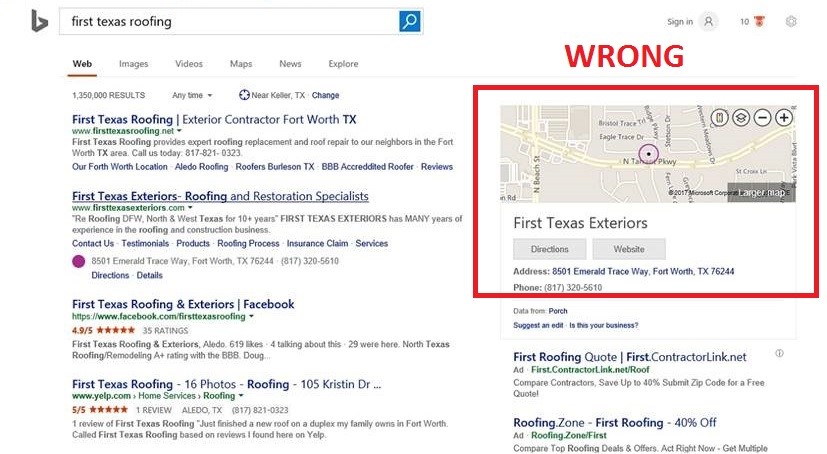
The Right Listing:
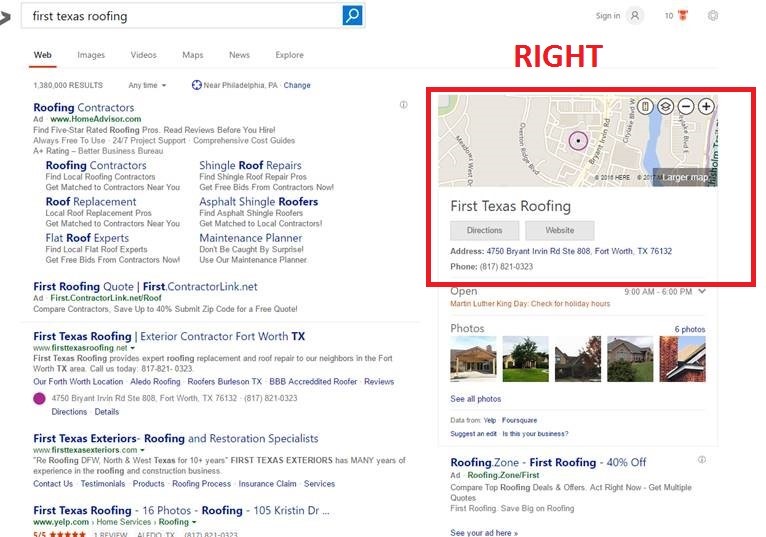
The difference between the two local listings (other than their similar business names) was the locations from which Bing was pulling the data from:
- Half the time, Bing was pulling from Yelp and Foursquare—and returned our client’s results.
- The other times, Bing was pulling info for our client’s competition from Porch.com.
This was likely happening because our client (First Texas Roofing) has two business locations (Aledo and Ft. Worth). The client had a Porch.com profile for Aledo, but not Fort Worth, so Bing was pulling a similar result from Porch.com (which is a reliable contractor website) for “First Texas Exteriors.”
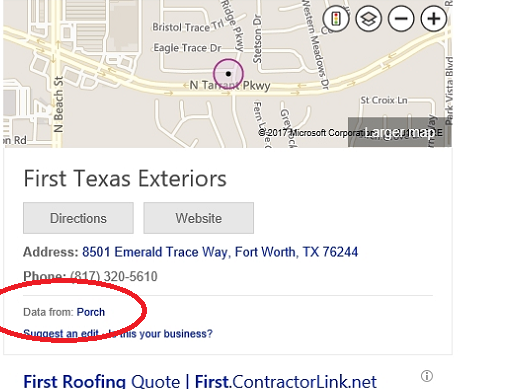
As soon as we saw the problem, we were all over it like Professor Dumbledore on a Horcrux.
Timeline:
2:20 PM: We noticed the issue and diagnosed it.
2:40 PM: We emailed the client to let him know what we saw and what and our plan to fix it (creating a listing for the Ft. Worth location and monitoring the results).
2:50 PM: We set up a Porch.com profile for First Texas Roofing in Ft. Worth.
Bam! Within 30 minutes, we prevented the client from losing out on a massive amount of internet leads.
Bottom Line: Google is your bread and butter for organic internet leads. But it pays to put some of your SEO efforts into Bing.
After all, as many as one in three prospects are searching for you there. That’s a heaping portion of profits you do NOT want to lose out on.
Lucky for you: When it comes to SEO, what’s good for the goose is often good for the gander.
Many of the things that help your website rank well on Google will also help you on Bing, and vice versa. These include business listings, social media presence, website architecture, and meta descriptions, to name a few.
Our SEO and website services focus on these… and a WHOLE lot more.
We build powerful, passionate, persuasive contractor websites that surge SEO rankings and transform lookers into chomping-at-the-bit buyers.
For more info, reach out to us by calling 817-416-4333 or using the Live Chat box on our website.
P.S. You’ll notice our SEO page only refers to Google. The reason is simple: that’s where most of your SEO leads will come from. Surprisingly, a few of Bing’s best SEO practices are diametrically opposed to Google’s. In those instances, we give preference to Google. It’s only logical!
Save
Posted by Rich Harshaw on February 2, 2017.

In an unpredictable world, only two things are certain year in and out:
- Income taxes.
- Google rolling out a new update that can drastically mess with your rankings.
I’m sure you’re all too aware of the first one, so let’s talk about the second.
What Google has gone and done for 2017 is create a mobile index, essentially separate mobile search results and desktop search results.
This is BIG because it could drastically affect your rankings on mobile devices.
Here are 5 key things you need to know:
-
What is Google’s mobile index?
The mobile index is going to rank pages based on the content that’s shown to a user on a mobile device, rather than ranking the results based on content served on the “full-size” page. Prior to this, Google has ranked its search results based on the content found on the desktop version of a page, regardless of whether or not the user searching was on a mobile device.
-
Do I need to worry?
If your mobile site is skimpy on content or not optimized for SEO, probably. If you have a robust, fleshed-out mobile site, however, you’ll be fine. In fact, since most companies’ mobile sites are terrible, you’ll likely see a big boost in your mobile results if you have a quality, mobile-friendly site.
-
What if I don’t have a mobile-friendly site?
First, if you don’t have a mobile-friendly site, what are you even doing? You’re likely hurting your conversions BIG TIME (reading “desktop” sites on a mobile device is the stuff of nightmares). It’s 2017 and everyone is glued to their smartphones—NOT having a mobile-friendly website is simply NOT an option anymore.
The good news is that if you don’t have a mobile site, Google will crawl your main website. Nothing changes in this instance.
-
How do I make my mobile site search-engine friendly?
The same way you make your “full” site Google friendly: relevant content, strategically placed keywords, “nerd” coding, and all that good stuff.
-
When Does Google’s mobile index roll out?
Google is currently testing their mobile index with some of its users. It probably won’t take effect for everyone for a few months.
Of course, MYM clients need not fear…
We’re always one step ahead of Google’s SEO shakeups.
We build our clients’ websites to be “responsive,” which means the sites respond to the visitor’s browser size.
Instead of detecting that a visitor is on their mobile phone, and then serving a completely separate version of the site, our sites detect the reader is on a mobile phone and serve the same content with mobile-friendly navigation.
This not only makes it easier for someone visiting the site to browse it on a phone, but also ensures the mobile-friendly version contains ALL of the juicy SEO content and features of the “full” site.
What this means: While contractors with crappy mobile sites will see their mobile search results sink into the Google abyss, our clients’ mobile rankings will rise to the top.
Need a powerful, high-converting website that’s mobile-friendly? You know where to go.
P.S. If you want to see one of our “responsive” websites in action, click on this client’s website and shrink the browser to a little less than half the width of your computer screen. Presto!
















